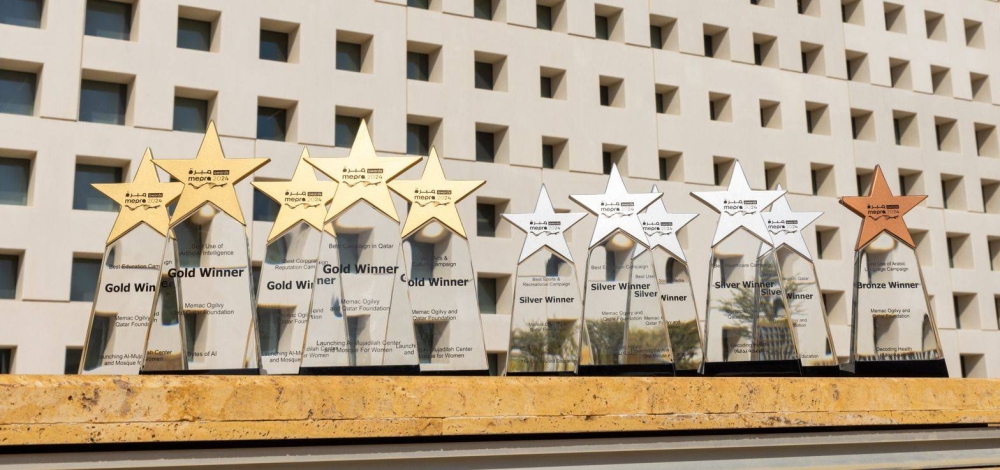
A giant, permanent graffiti installation that paints a picture of Qatari life using contemporary imagery is nearing completion on the wall of a school in Education City.
The 84m-long piece of urban art was commissioned by Qatar Foundation and features the work of three young local artists – Thamer Al Dossari, Mubarak Al-Malik and Moza AlKuwari.

The 4m-high perimeter wall of Qatar Academy primary school has been the artists’ open-air canvas since they started work on it early last month and despite its vast scale, is nearly finished.
A combination of each artist’s style, the mural features a woman wearing a batoola (traditional bronze-colored face covering), a prize-winning show horse from Al Shaqab, Arabic calligraphy, an incense burner and a wooden dhow.
They aim to portray messages of strength, kindness, momentum, history and anticipation, the artists said.
This is not the first time that grafitti-style work has been commissioned for public display in Qatar.

In 2013, Qatar Museums and Ashghal commissioned French Tunisian graffiti artist eL Seed to decorate four tunnels on the expanded Salwa Road using what he calls “calligraffiti” – a mixture of street art and Arabic calligraphy.
Creating the mural
The idea for the mural came from QF employee and Qatari artist Ameera Al Aji, who proposed the concept over a year ago.
Once the project was given the go-ahead, the three artists were brought in to begin designing the wall.
It took some 11 months to plan out, with the artists meeting nine times to sketch out the entire artwork. Initial plans included more portraits, but were shelved in favor of a simpler result.

Work on the wall began on Nov. 5, and was billed as an on-going public exhibition.
Residents are invited to watch the artists work during evenings, interact and observe their process, though attendance has been low so far.
Most of the wall-space is dedicated to work by Al Dossari, a project manager for Qatar Tourism Authority, and sports teacher Al Malik. The pair were childhood friends and among the country’s first graffiti artists.
The two picked up on the form around three years ago, teaching themselves by watching YouTube videos after famous artists like Banksy made the idea of graffiti as art more popular.
Al Malik’s work, featuring vibrantly colored Qatari woman, traditional symbols and chunky graffiti prints, has appeared on numerous abandoned buildings around the country. His pieces are also part of a specially curated collection of artwork at Hamad International Airport.
Al-Malik, whose work focuses on black and white portraits and horses, is also one of the few Qatari artists who chooses airbrushing as his favored medium.
Speaking to Doha News, he said:
“I picked it (airbrushing) up after a visit to (Los Angeles) some years ago. I saw a t-shirt artist on the street who created works in a matter of minutes.
I think I bought five t-shirts that day just to watch his work. We eventually became friends, and he introduced the art form to me, and since then, I’ve loved it. When I got back to Qatar, I just knew that I had to incorporate what I had learnt into my work, and help spread the word of it here,” he said.
Most of the work on the wall has been drawn free-form, though the artists anticipate using projectors this week to ensure the figures are drawn to proper scale.
So far, the size of the work has been a challenge. The centerpiece of the artwork, the Qatari woman in the traditional batoola, took Al-Malik four weeks to complete, while Al Dossari said the horse is the biggest he has ever drawn.
AlKuwari’s work includes two calligraphy pieces of random letters drawn in a rare Arabic script, and breaks up the graffiti styles of Al Dossari and Al-Malik.

“I chose the color green for one of them because it represents the colours of QF. The letters don’t mean anything, but were chosen because of their curves and elegance, and to fit within the overall image of a circular shape,” she said.
The only other time AlKuwari has worked on such a large scale was for an 8m calligraphy-inspired piece that was commissioned by Commercial Bank.
Access to tools
One of the main challenges that all three artists have faced is a shortage of materials.
As most aerosol cans favored by graffiti artists have a high alcohol content, they are not usually stocked in many of the country’s art supply stores.

“There’s not a lot of range here. There are only one or two stores that stock these types of paints, and even then, the colors are limited. We have to learn to make do with what we have available,” Al Dossari said, adding that the artists have had to import a majority of the paints used during this project to keep up with the volume needed.
The artists also said that previously, they had refused numerous projects simply because they didn’t have access to the necessary paints in the country.
For those who want to watch the trio in action, the artists will be painting each week night starting around 3pm. There are also apparently snacks and drinks for visitors:
Thoughts?







